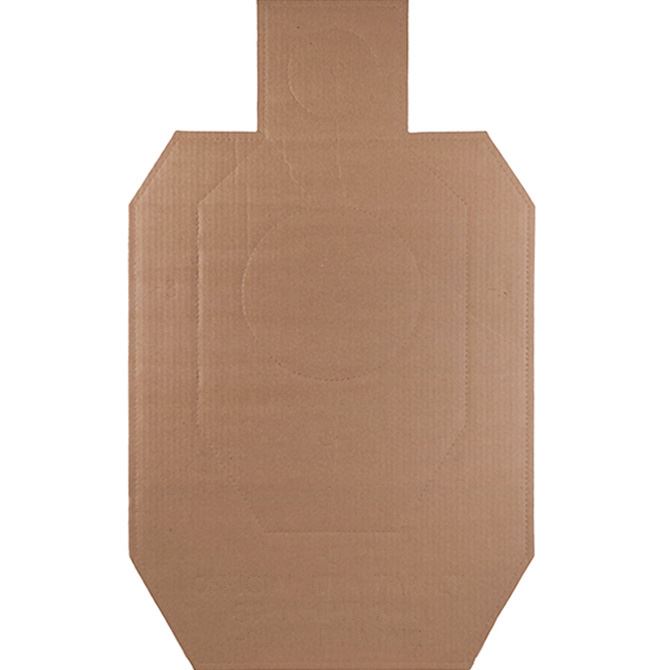At Black Rifle League, we use the widely used IDPA targets as shown below. However to score points at Black Rifle League, our scoring system operates a little differently

|
SHOOTING RULES |
A tactical garment is not required for any stages but encouraged.
Police or active duty military personnel may use actual duty gear matches. See definition of duty gear in the Equipment Section.
- When exposed to a target, a shooter must engage that target within 3 seconds
- A shooter must clear, and may not stand in the “fatal funnel” of a doorway. A fatal funnel is the threshold of a room that must be pushed through. A shooter may “pie” a room from the outside, or rush into a room, but may not stand in the doorway. Not Clearing a “fatal funnel” will result in a Procedural Error.
- Once a “room” or space has been “cleared”, a shooter may not go back and re-engage targets once engaged, and the shooter has left the room.
- All targets must be engaged in tactical priority, including all targets engaged “in the open.”
- Tactical Priority is method of target engagement in which targets are engaged by their order of threat. Threat is based on the distance of the visible threats from the shooter. Targets are considered equal threat when the difference in the target distances to the shooter is less than 2 yards.
- If several targets are visible at the same time, targets are engaged from near-to-far unless they are equal threat.
If targets are hidden by cover, the targets are engaged as they become visible around the edge of cover (slicing the pie). A target is considered “Engaged” when:
- A cardboard target is deemed to have been engaged when the required number of shots for that target have been fired at the target.
- Body and head shots may be required on an individual visible cardboard target and must be shot in the order and quantity stipulated in the CoF. Failure to shoot one or more targets in the required body then head order earns the shooter a single PE.
- Targets may be re-engaged from multiple shooting positions provided the shooter does not break the defined Muzzle Safe Points see section 2.9, and “room” is not re-entered, and the shooter is continuing the CoF.
- A minimum of 6/12 targets must be engaged with the rifle for the run to count, in the event of an equipment malfunction.
- A minimum of 9/12 targets must be engaged with the rifle to count in the event of no rifle malfunction.
|
RELOADS |
- Dropping a loaded magazine does not incur a penalty as long as the shooter retrieves and properly stows the loaded magazine, and reloads it again to use all rifle rounds, prior to the firing of the last shot in the string of fire.
- When clearing a malfunction, the magazine that may have caused the malfunction does not need to be retained by the shooter and will incur no penalty if dropped, as long as the shooter picks up the magazine and continues.
- Rifle magazines must always be loaded to the capacity limit of 10, unless otherwise specified by the Event Safety Officer.
- Firearms and magazines manufactured such that they cannot be loaded to the division capacity may still be used.
|
COVER & CONCEALMENT |
- When cover is available it must be used, while engaging targets, unless the shooter is “in the open” and must engage targets “in the open” within 3 seconds. Shooters may not cross or enter any openings (doorways, open spaces, etc.) without first engaging targets visible from those locations.
- Cover During Reloads
A. When the shooter runs the firearm empty in the open, the shooter may reload in the open and continue engaging targets as needed or move to the next shooting position, but all targets must be engaged within 3 seconds.
B. In stages with cover or concealment, shooters may reload standing still or on the move at any time, as long as they are not exposed to targets that are not fully engaged during the reload.
|
SCORING RULES |
The scoring system in BRL is designed to reward a balance of tactical soundness and accuracy. BRL scoring converts everything to a point score and the highest points wins. The scoring system is also designed to be very simple to understand and use.
The main thing to remember when scoring in BRL is that everything is based on tactical soundness and accuracy, where speed promoted inaccuracy reduces the score. Part of the simplicity of BRL scoring comes from using the total points of a target hit, instead of using time as the prime score.
|
SHOOT THROUGH |
Because of the tactical nature of BRL, the safety of non-threats is of paramount importance. When a bullet passes through a non-threat target and also strikes a threat target, the shooter will get the penalty for the non-threat target hit. The reverse also applies when a round on a threat target penetrates a non-threat or threat behind it. Any hit on a non-threat will negate the shooters score for that run.
Hit on Non-Threat
- A Hit on Non-Threat (HNT) is defined as a hit in any scoring zone of a target that is designated a non-threat. A reactive non-threat target (steel, reactive polymer, etc.) must react properly to a hit to be scored as a HNT.
- Each hit on a Non-Threat negates to the shooter’s score for that run, and the shooter receives zero points, or the run is “scrubbed”.
|
PENALTY RULES |
In order for a Procedural Error (PE) or Flagrant Penalty (FP) to be assessed for a failure to perform actions other than shooting, there must be a defined, measurable qualifier for how a prop is to be used appropriately. Under no circumstances is a penalty of any type to be assessed based on a judgment call on whether or not the prop was used appropriately during the CoF. The qualifier must be of a pass/fail determinant and the quantifiable condition must be in the CoF. e.g., the briefcase must be set down inside blue barrel.
|
DISQUALIFICATION (DQ) |
Disqualification means the shooter may not continue in any part of the BRL match, may not reenter in another division, and may not shoot any side matches. The shooter’s score will be reported as DQ. A shooter must be disqualified for the following reasons:
A. Unsafe firearm handling as defined in the Safety Rules Section.
B. Unsportsmanlike conduct.
C. Violations of the Shooter’s Code of Conduct as determined by the Match Director
D. Shooting at a steel target that is less than 10 yards from the shooter.
E. Intentionally discharging the firearm at anything other than a target or an activator.
F. Having a round in chamber when transitioning to pistol. At the end of the stage, if your rifle has a round chambered when asked to "unload and show clear"
All DQs must be confirmed by the MD.

